Simulating Urban Expansion from the Perspective of Spatial Anisotropy and Expansion Neighborhood
Abstract
1. Introduction
- (1)
- Introducing the Spatial Anisotropy Index (SAI) to measure the anisotropic characteristics of various land-use types, this study concurrently attempts to integrate this index with traditional urban dynamic simulation models. The aim is to explore the role and driving mechanisms of spatial anisotropy features in revealing patterns of urban expansion.
- (2)
- The integration of spatial interaction models (such as gravity models) with cellular automaton-based urban expansion models is aimed at providing a more comprehensive insight into the driving mechanisms and anisotropic characteristics of urban expansion.
- (3)
- Using the perspective of expansion neighborhoods to address the issue of cellular invalidity caused by traditional neighborhood effects.
2. Materials and Methods
2.1. Study Area
2.2. Data
2.3. Methods
2.3.1. Spatial Anisotropy Module
- : The anisotropy index of a certain land type.
- : The number of cells of a certain type along the line connecting the central city cell and the observation point.
- : The total number of cells along the line connecting the central city cell and the observation point.
2.3.2. Neighborhood Effect Extraction Module
2.3.3. CA Dynamic Iteration Module Based on Urban Inter-City Gravity Model
- (1)
- Comprehensive Suitability Extraction
- (2)
- Gravity-Guided Iteration Module
2.3.4. Model Validation Module
- : The anisotropy index of a certain land type.
- A: The total number of samples or grid cells.
- : Kappa coefficient.
- : The sum of correctly classified samples for each class divided by the total number of samples, i.e., overall classification accuracy.
- : The sum of the products of actual and predicted quantities for each category, divided by the square of the total number of samples.
3. Results
3.1. Model Training and Prediction
3.1.1. Training Model and Key Steps
3.1.2. Analysis of Spatial Anisotropy Results
| Algorithm 1 Get spatial anisotropic probability layer pseudocode. |
| Input: 2010 land use raster data LandUse (2290 × 2438), coordinates of the first quadrant research point in point1.txt Output: SA_pro (spatial anisotropy probability) |
Process:
|
3.1.3. Expanded Neighborhood Result Analysis
3.1.4. Analysis of Urban Gravity Results
3.1.5. Model Simulation Results
3.2. Simulation Result Evaluation
Accuracy Comparison
| Parameter | RF-CNN-SAI-CA (Dynamic Neighborhood-Gravitational Model) | RF-CNN-SAI-CA (Dynamic Neighborhood) | RF-CNN-SAI-CA |
|---|---|---|---|
| Kappa | 0.8561 | 0.8457 | 0.8397 |
| FOM | 0.4596 | 0.4486 | 0.4431 |
| OA | 0.9896 | 0.9862 | 0.9798 |
| Parameter | RF-CNN-CA | RF-CA | FA-MLP-CA | RF-SNSCNN-CA |
|---|---|---|---|---|
| Kappa | 0.8376 | 0.8154 | 0.6984 | 0.7683 |
| FOM | 0.4322 | 0.4067 | 0.3942 | 0.3836 |
| OA | 0.9766 | 0.9742 | 0.9789 | 0.9782 |
4. Discussion
- (1)
- The conventional urban expansion simulations often lack the probability trend of cells converting to specific land use types in particular directions, resulting in inaccurate simulation outcomes. This paper successfully enhances the precision of urban expansion simulation by introducing Cellular Directional Probability (SAI). This innovative approach allows the model to more accurately mirror the genuine patterns of urban expansion and offers fresh insights into analogous spatiotemporal simulation issues.
- (2)
- In addition to accounting for directional probability within the city, this study also incorporates the gravity model formula to investigate the influence of intercity attraction on urban expansion simulation. Through an analysis of the gravitational relationship between Chongqing and eight surrounding cities, this research reveals that the urban expansion process is impacted not solely by internal factors but also by the mutual attraction among cities. This discovery underscores the significance of intercity interactions in urban expansion simulations.
- (3)
- Neighborhood effects are crucial considerations in urban expansion simulations. However, traditional methods face an issue of cellular neighborhood failure. To address this problem, this paper proposes a solution by integrating the expanded neighborhood and a CNN-based neighborhood effect model. Through this innovative approach, this paper successfully enhanced simulation accuracy, effectively remedying the issue of cell loss in the neighborhood effect, thus rendering the simulation results more precise.
Author Contributions
Funding
Data Availability Statement
Acknowledgments
Conflicts of Interest
Appendix A
| Area | Quality | Area | Quality | Cities | Quality |
|---|---|---|---|---|---|
| Yuzhong | 754.46 | Fuling | 640.81 | Chengdu | 2226.51 |
| Dadukou | 324.54 | Changshou | 394.89 | Guangan | 1466.94 |
| Jiangbei | 599.88 | Jiangjin | 573.23 | Dazhou | 2002.38 |
| Shapingba | 664.42 | Hechuan | 538.25 | Luzhou | 2159.32 |
| Jiulongpo | 952.44 | Yongchuan | 556.59 | Zunyi | 2229.54 |
| Nanan | 503.21 | Nanchuan | 229.28 | Neijiang | 1337.84 |
| Beibei | 426.18 | Qijiang | 428.95 | Tongren | 1203.35 |
| Yubei | 902.79 | Dazu | 374.76 | Qianjiang | 1053.71 |
| Banan | 618.84 | Bishan | 399.94 | ||
| Tongnan | 366.43 | Tongliang | 334.21 | ||
| Rongchang | 245.75 |
| City | Chengdu | Guangan | Dazhou | Luzhou | Zunyi | Neijiang | Tongren | Qianjiang |
|---|---|---|---|---|---|---|---|---|
| Yuzhong | 315.05 | 145.22 | 228.87 | 170.90 | 237.60 | 180.10 | 534.88 | 277.25 |
| Dadukou | 314.97 | 164.04 | 247.69 | 169.64 | 231.28 | 172.60 | 496.67 | 272.71 |
| Jiangbei | 294.50 | 114.60 | 220.10 | 182.59 | 250.60 | 188.28 | 538.93 | 281.53 |
| Shapingba | 286.50 | 127.50 | 234.76 | 161.10 | 248.30 | 171.21 | 506.49 | 281.17 |
| Jiulongpo | 295.90 | 152.82 | 240.17 | 158.80 | 241.30 | 162.60 | 529.59 | 274.20 |
| Nanan | 324.40 | 151.27 | 242.70 | 170.50 | 239.20 | 191.52 | 450.10 | 269.95 |
| Beibei | 282.42 | 123.24 | 231.91 | 180.20 | 284.71 | 183.00 | 495.62 | 316.70 |
| Yubei | 310.60 | 106.80 | 209.50 | 193.61 | 257.59 | 198.52 | 554.91 | 297.71 |
| Banan | 304.50 | 164.69 | 240.87 | 196.20 | 258.10 | 184.43 | 486.45 | 266.00 |
| Tongnan | 209.36 | 151.57 | 309.97 | 233.18 | 339.42 | 151.38 | 606.14 | 380.34 |
| Rongchang | 253.40 | 225.09 | 333.75 | 96.48 | 329.8 | 76.00 | 710.20 | 370.46 |
| Fuling | 394.90 | 177.32 | 261.20 | 251.40 | 299.63 | 278.31 | 435.10 | 215.51 |
| Changshou | 369.40 | 137.38 | 221.30 | 233.38 | 292.07 | 251.17 | 472.62 | 235.85 |
| Jiangjin | 317.70 | 175.28 | 279.20 | 123.30 | 227.58 | 174.32 | 470.80 | 290.21 |
| Hechuan | 278.75 | 86.60 | 257.28 | 144.70 | 307.92 | 198.82 | 598.00 | 343.73 |
| Yongchuan | 288.75 | 193.10 | 297.54 | 104.60 | 294.11 | 112.11 | 514.50 | 334.55 |
| Nanchuan | 381.30 | 226.84 | 304.30 | 207.70 | 237.71 | 250.98 | 434.72 | 196.02 |
| Qijiang | 366.30 | 212.56 | 296.21 | 157.10 | 181.71 | 228.30 | 470.58 | 260.18 |
| Dazu | 220.50 | 182.39 | 311.30 | 125.90 | 331.20 | 108.80 | 542.10 | 442.90 |
| Bishan | 269.10 | 143.81 | 263.87 | 165.51 | 269.50 | 158.08 | 566.93 | 303.30 |
| Tongliang | 255.60 | 126.70 | 272.00 | 166.40 | 305.20 | 149.20 | 560.64 | 335.32 |
| City | Chengdu | Guangan | Dazhou | Luzhou | Zunyi | Neijiang | Tongren | Qianjiang |
|---|---|---|---|---|---|---|---|---|
| Yuzhong | 16.92 | 52.48 | 28.84 | 55.77 | 29.79 | 31.11 | 3.17 | 10.34 |
| Dadukou | 7.28 | 17.69 | 10.59 | 24.35 | 13.52 | 14.57 | 1.58 | 4.59 |
| Jiangbei | 15.39 | 67.00 | 24.79 | 38.85 | 21.29 | 22.63 | 2.48 | 7.97 |
| Shapingba | 18.02 | 59.95 | 24.14 | 55.28 | 24.02 | 30.32 | 3.11 | 8.85 |
| Jiulongpo | 24.21 | 59.82 | 33.06 | 81.55 | 36.47 | 48.19 | 4.08 | 13.34 |
| Nanan | 10.64 | 32.25 | 17.10 | 37.37 | 19.60 | 18.35 | 2.98 | 7.27 |
| Beibei | 11.89 | 41.16 | 15.86 | 28.34 | 11.72 | 17.02 | 2.08 | 4.47 |
| Yubei | 20.83 | 116.10 | 41.18 | 52.00 | 30.33 | 30.64 | 3.52 | 10.73 |
| Banan | 14.86 | 33.47 | 21.35 | 34.71 | 20.71 | 24.33 | 3.14 | 9.21 |
| Tongnan | 18.61 | 23.39 | 7.63 | 14.55 | 7.09 | 21.39 | 1.20 | 2.66 |
| Rongchang | 8.52 | 5.54 | 4.41 | 57.00 | 5.03 | 56.92 | 0.58 | 1.88 |
| Fuling | 9.14 | 29.89 | 18.80 | 21.89 | 15.91 | 11.06 | 4.07 | 14.53 |
| Changshou | 6.44 | 30.69 | 16.14 | 15.65 | 10.32 | 8.37 | 2.12 | 7.48 |
| Jiangjin | 12.64 | 27.37 | 14.72 | 81.41 | 24.67 | 25.23 | 3.11 | 7.17 |
| Hechuan | 15.42 | 105.28 | 16.28 | 55.50 | 12.65 | 18.21 | 1.81 | 4.8 |
| Yongchuan | 14.86 | 21.89 | 12.58 | 109.84 | 14.34 | 59.24 | 2.53 | 5.24 |
| Nanchuan | 3.51 | 6.53 | 4.95 | 11.47 | 9.04 | 4.86 | 1.45 | 6.28 |
| Qijiang | 7.11 | 13.92 | 9.78 | 37.52 | 28.96 | 11.01 | 2.33 | 6.67 |
| Dazu | 17.16 | 16.52 | 7.74 | 51.05 | 7.61 | 42.35 | 1.53 | 2.01 |
| Bishan | 12.29 | 28.36 | 11.50 | 31.52 | 12.27 | 21.41 | 1.49 | 4.58 |
| Tongliang | 11.38 | 30.54 | 9.04 | 26.06 | 7.99 | 20.08 | 1.27 | 3.13 |
References
- Chettry, V. A Critical Review of Urban Sprawl Studies. J. Geovisualization Spat. Anal. 2023, 7, 28. [Google Scholar] [CrossRef]
- Junliang, D.; Xiaolu, G.; Shoushuai, D. Expansion of Urban Space and Land Use Control in the Process of Urbanization: An Overview. Chin. J. Popul. Resour. Environ. 2010, 8, 73–82. [Google Scholar] [CrossRef]
- Bai, X.; McPhearson, T.; Cleugh, H.; Nagendra, H.; Tong, X.; Zhu, T.; Zhu, Y.-G. Linking Urbanization and the Environment: Conceptual and Empirical Advances. Annu. Rev. Environ. Resour. 2017, 42, 215–240. [Google Scholar] [CrossRef]
- Lau, K.H.; Kam, B.H. A Cellular Automata Model for Urban Land-Use Simulation. Environ. Plan. B Plan. Des. 2005, 32, 247–263. [Google Scholar] [CrossRef]
- Tong, X.; Feng, Y. A Review of Assessment Methods for Cellular Automata Models of Land-Use Change and Urban Growth. Int. J. Geogr. Inf. Sci. 2020, 34, 866–898. [Google Scholar] [CrossRef]
- Grinblat, Y.; Gilichinsky, M.; Benenson, I. Cellular Automata Modeling of Land-Use/Land-Cover Dynamics: Questioning the Reliability of Data Sources and Classification Methods. Ann. Am. Assoc. Geogr. 2016, 106, 1299–1320. [Google Scholar] [CrossRef]
- Rimal, B.; Zhang, L.; Keshtkar, H.; Haack, B.; Rijal, S.; Zhang, P. Land Use/Land Cover Dynamics and Modeling of Urban Land Expansion by the Integration of Cellular Automata and Markov Chain. ISPRS Int. J. Geo-Inf. 2018, 7, 154. [Google Scholar] [CrossRef]
- Li, X.; Liu, X.; Yu, L. A Systematic Sensitivity Analysis of Constrained Cellular Automata Model for Urban Growth Simulation Based on Different Transition Rules. Int. J. Geogr. Inf. Sci. 2014, 28, 1317–1335. [Google Scholar] [CrossRef]
- He, J.; Li, X.; Yao, Y.; Hong, Y.; Jinbao, Z. Mining Transition Rules of Cellular Automata for Simulating Urban Expansion by Using the Deep Learning Techniques. Int. J. Geogr. Inf. Sci. 2018, 32, 2076–2097. [Google Scholar] [CrossRef]
- Xiao, B.; Liu, J.; Jiao, J.; Li, Y.; Liu, X.; Zhu, W. Modeling Dynamic Land Use Changes in the Eastern Portion of the Hexi Corridor, China by Cnn-Gru Hybrid Model. GIScience Remote Sens. 2022, 59, 501–519. [Google Scholar] [CrossRef]
- Li, X.; Yang, Q.; Liu, X. Genetic Algorithms for Determining the Parameters of Cellular Automata in Urban Simulation. Sci. China Ser. D-Earth Sci. 2007, 50, 1857–1866. [Google Scholar] [CrossRef]
- Guan, D.; Zhao, Z.; Tan, J. Dynamic Simulation of Land Use Change Based on Logistic-CA-Markov and WLC-CA-Markov Models: A Case Study in Three Gorges Reservoir Area of Chongqing, China. Environ. Sci. Pollut. Res. 2019, 26, 20669–20688. [Google Scholar] [CrossRef]
- Wu, L.; Zhu, M.; Zhang, G.; Yang, R. Simulation of Land Use Changes in Jiaodong Peninsular Based on the Logistic-CA-Markov Model. J. Phys. Conf. Ser. 2020, 1622, 012092. [Google Scholar] [CrossRef]
- Kamusoko, C.; Gamba, J. Simulating Urban Growth Using a Random Forest-Cellular Automata (RF-CA) Model. ISPRS Int. J. Geo-Inf. 2015, 4, 447–470. [Google Scholar] [CrossRef]
- Pan, X.; Liu, Z.; He, C.; Huang, Q. Modeling Urban Expansion by Integrating a Convolutional Neural Network and a Recurrent Neural Network. Int. J. Appl. Earth Obs. Geoinf. 2022, 112, 102977. [Google Scholar] [CrossRef]
- Yan, Y.; Jiang, L.; He, X.; Hu, Y.; Li, J. Spatio-Temporal Evolution and Influencing Factors of Scientific and Technological Innovation Level: A Multidimensional Proximity Perspective. Front. Psychol. 2022, 13, 920033. [Google Scholar] [CrossRef] [PubMed]
- Raheem, A.M.; Naser, I.J.; Ibrahim, M.O.; Omar, N.Q. Inverse Distance Weighted (IDW) and Kriging Approaches Integrated with Linear Single and Multi-Regression Models to Assess Particular Physico-Consolidation Soil Properties for Kirkuk City. Model. Earth Syst. Environ. 2023, 9, 3999–4021. [Google Scholar] [CrossRef]
- Zhang, X.; Lu, H.; Holt, J.B. Modeling Spatial Accessibility to Parks: A National Study. Int. J. Health Geogr. 2011, 10, 31. [Google Scholar] [CrossRef]
- Feng, Y.; Liu, Y.; Batty, M. Modeling Urban Growth with GIS Based Cellular Automata and Least Squares SVM Rules: A Case Study in Qingpu–Songjiang Area of Shanghai, China. Stoch. Environ. Res. Risk Assess. 2016, 30, 1387–1400. [Google Scholar] [CrossRef]
- Liang, X.; Liu, X.; Li, D.; Zhao, H.; Chen, G. Urban Growth Simulation by Incorporating Planning Policies into a CA-Based Future Land-Use Simulation Model. Int. J. Geogr. Inf. Sci. 2018, 32, 2294–2316. [Google Scholar] [CrossRef]
- Nie, W.; Xu, B.; Ma, S.; Yang, F.; Shi, Y.; Liu, B.; Hao, N.; Wu, R.; Lin, W.; Bao, Z. Coupling an Ecological Network with Multi-Scenario Land Use Simulation: An Ecological Spatial Constraint Approach. Remote Sens. 2022, 14, 6099. [Google Scholar] [CrossRef]
- Shen, Z.; Kawakami, M.; Kawamura, I. Geosimulation Model Using Geographic Automata for Simulating Land-Use Patterns in Urban Partitions. Environ. Plann. B 2009, 36, 802–823. [Google Scholar] [CrossRef]
- Van Duynhoven, A.; Dragićević, S. Mitigating Imbalance of Land Cover Change Data for Deep Learning Models with Temporal and Spatiotemporal Sample Weighting Schemes. ISPRS Int. J. Geo-Inf. 2022, 11, 587. [Google Scholar] [CrossRef]
- Zhao, Y.W.; Xu, M.J.; Xu, F.; Wu, S.R.; Yin, X.A. Development of a Zoning-Based Environmental–Ecological Coupled Model for Lakes: A Case Study of Baiyangdian Lake in Northern China. Hydrol. Earth Syst. Sci. 2014, 18, 2113–2126. [Google Scholar] [CrossRef]
- Chen, B.Y.; Yuan, H.; Li, Q.; Shaw, S.-L.; Lam, W.H.K.; Chen, X. Spatiotemporal Data Model for Network Time Geographic Analysis in the Era of Big Data. Int. J. Geogr. Inf. Sci. 2016, 30, 1041–1071. [Google Scholar] [CrossRef]
- Zhang, J.; Ling, Y.; Zhu, A.-X.; Zeng, H.; Song, J.; Zhu, Y.; Qian, L. Incorporation of Spatial Anisotropy in Urban Expansion Modelling with Cellular Automata. Int. J. Geogr. Inf. Sci. 2022, 36, 86–113. [Google Scholar] [CrossRef]
- Feng, Y.; Tong, X. Incorporation of Spatial Heterogeneity-Weighted Neighborhood into Cellular Automata for Dynamic Urban Growth Simulation. GIScience Remote Sens. 2019, 56, 1024–1045. [Google Scholar] [CrossRef]
- Chai, D.; Du, J.; Yu, Z.; Zhang, D. City Network Mining in China’s Yangtze River Economic Belt Based on “Two-Way Time Distance” Modified Gravity Model and Social Network Analysis. Front. Phys. 2022, 10, 1018993. [Google Scholar] [CrossRef]
- Fan, Y.; Zhang, S.; He, Z.; He, B.; Yu, H.; Ye, X.; Yang, H.; Zhang, X.; Chi, Z. Spatial Pattern and Evolution of Urban System Based on Gravity Model and Whole Network Analysis in the Huaihe River Basin of China. Discret. Dyn. Nat. Soc. 2018, 2018, 3698071. [Google Scholar] [CrossRef]
- Sun, Q.; Wang, S.; Zhang, K.; Ma, F.; Guo, X.; Li, T. Spatial Pattern of Urban System Based on Gravity Model and Whole Network Analysis in Eight Urban Agglomerations of China. Math. Probl. Eng. 2019, 2019, 6509726. [Google Scholar] [CrossRef]
- Han, R.; Cao, H.; Liu, Z. Studying the Urban Hierarchical Pattern and Spatial Structure of China Using a Synthesized Gravity Model. Sci. China Earth Sci. 2018, 61, 1818–1831. [Google Scholar] [CrossRef]
- Zhai, H. Evaluation of China-ASEAN Trade Status and Trade Potential: An Empirical Study Based on a Gravity Model. PLoS ONE 2023, 18, e0290897. [Google Scholar] [CrossRef]
- Gu, Y.; Guo, P. Study on the Countermeasures of the Gravity Model of Wuhan City Circle. In Proceedings of the 2018 8th International Conference on Management, Education and Information (MEICI 2018), Shenyang, China, 21–23 September 2018; Atlantis Press: Shenzang, China, 2018. [Google Scholar]
- Zeng, N.; Wang, Z.; Liu, W.; Zhang, H.; Hone, K.; Liu, X. A Dynamic Neighborhood-Based Switching Particle Swarm Optimization Algorithm. IEEE Trans. Cybern. 2022, 52, 9290–9301. [Google Scholar] [CrossRef]
- Wang, F.; Marceau, D.J. A Patch-based Cellular Automaton for Simulating Land-use Changes at Fine Spatial Resolution. Trans. GIS 2013, 17, 828–846. [Google Scholar] [CrossRef]
- Wu, H.; Zhou, L.; Chi, X.; Li, Y.; Sun, Y. Quantifying and Analyzing Neighborhood Configuration Characteristics to Cellular Automata for Land Use Simulation Considering Data Source Error. Earth Sci. Inform. 2012, 5, 77–86. [Google Scholar] [CrossRef]
- Yao, Y.; Liu, X.; Li, X.; Liu, P.; Hong, Y.; Zhang, Y.; Mai, K. Simulating Urban Land-Use Changes at a Large Scale by Integrating Dynamic Land Parcel Subdivision and Vector-Based Cellular Automata. Int. J. Geogr. Inf. Sci. 2017, 31, 2452–2479. [Google Scholar] [CrossRef]
- Pontius, R.G.; Boersma, W.; Castella, J.-C.; Clarke, K.; De Nijs, T.; Dietzel, C.; Duan, Z.; Fotsing, E.; Goldstein, N.; Kok, K.; et al. Comparing the Input, Output, and Validation Maps for Several Models of Land Change. Ann. Reg. Sci. 2008, 42, 11–37. [Google Scholar] [CrossRef]

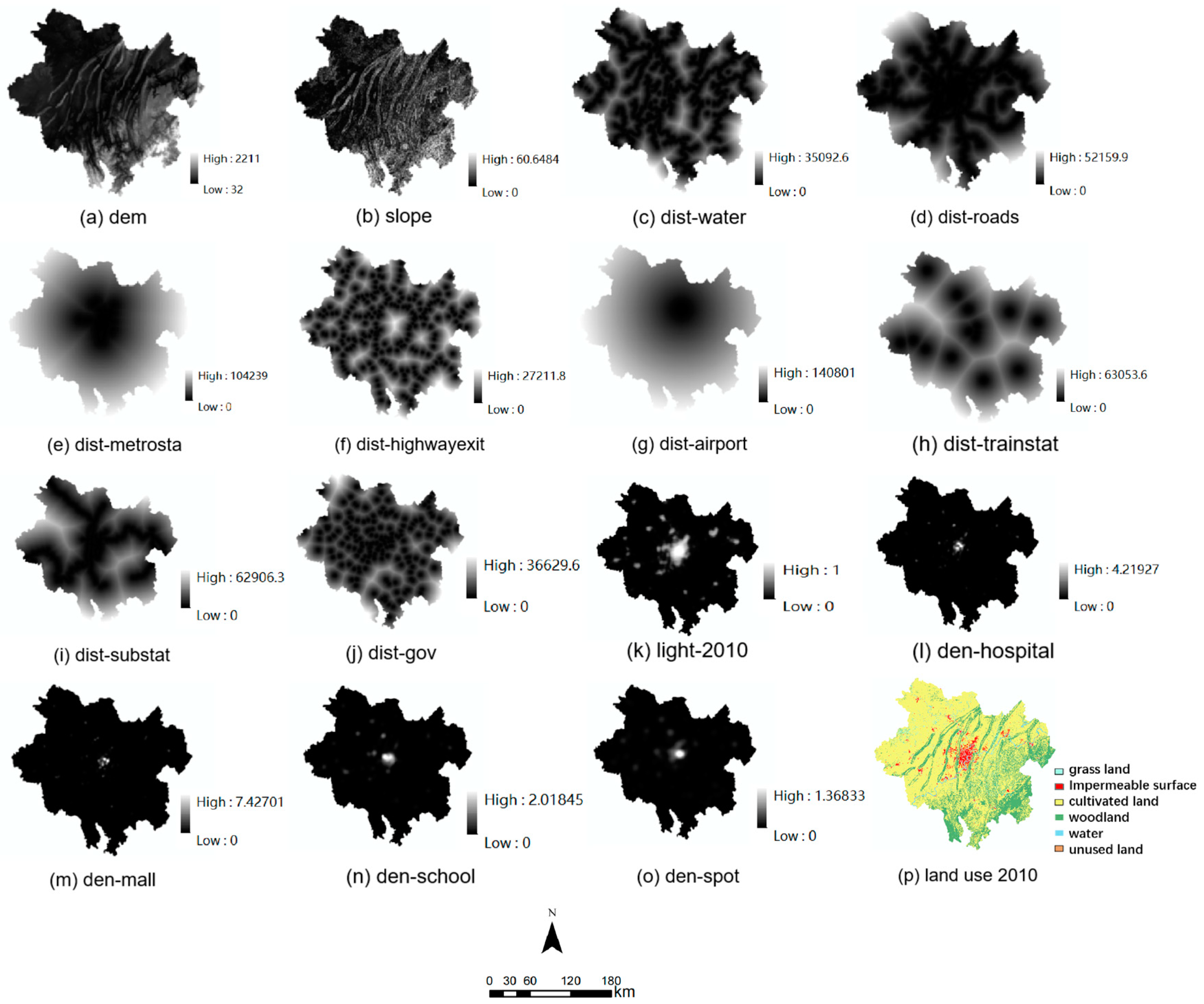
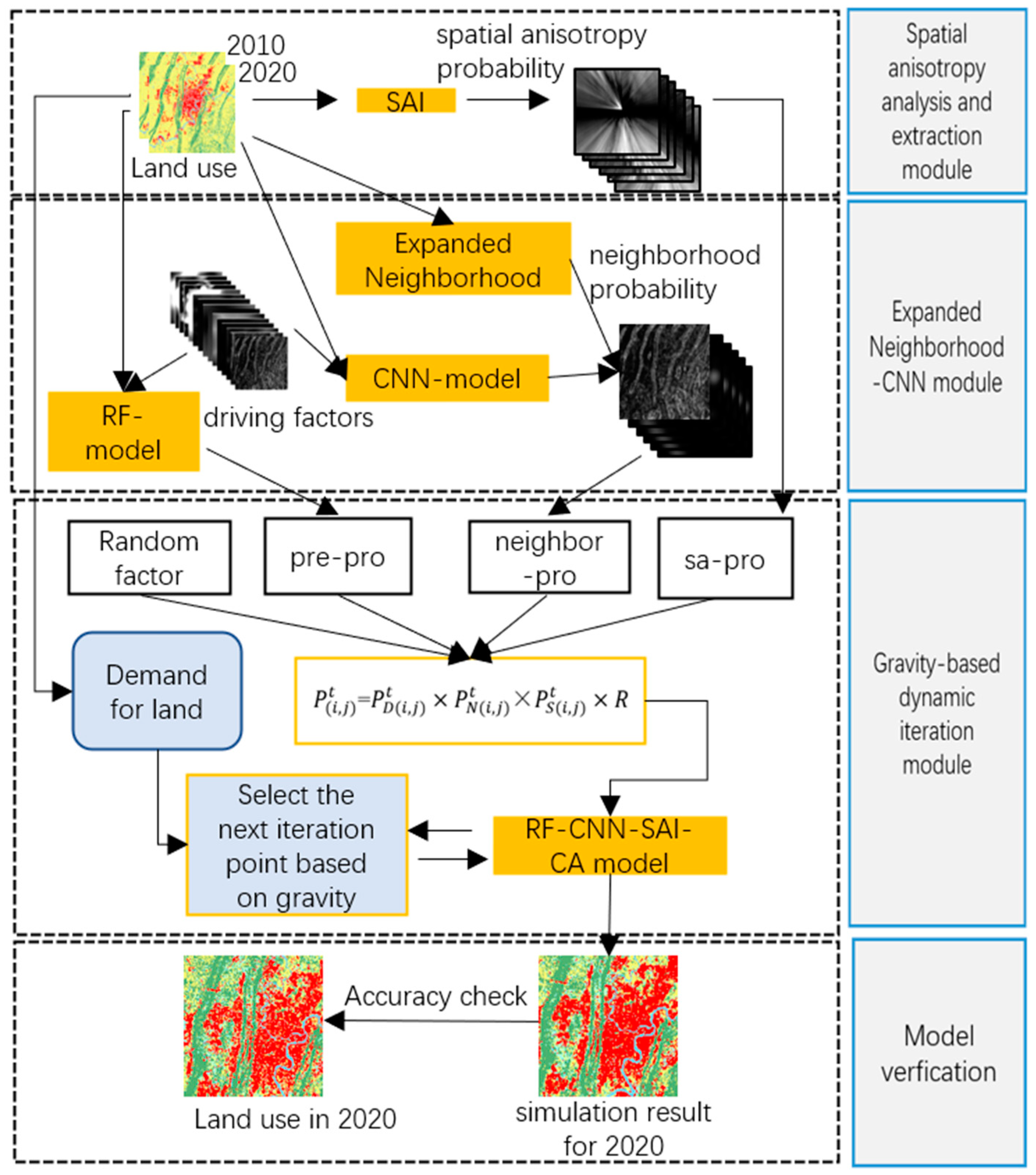

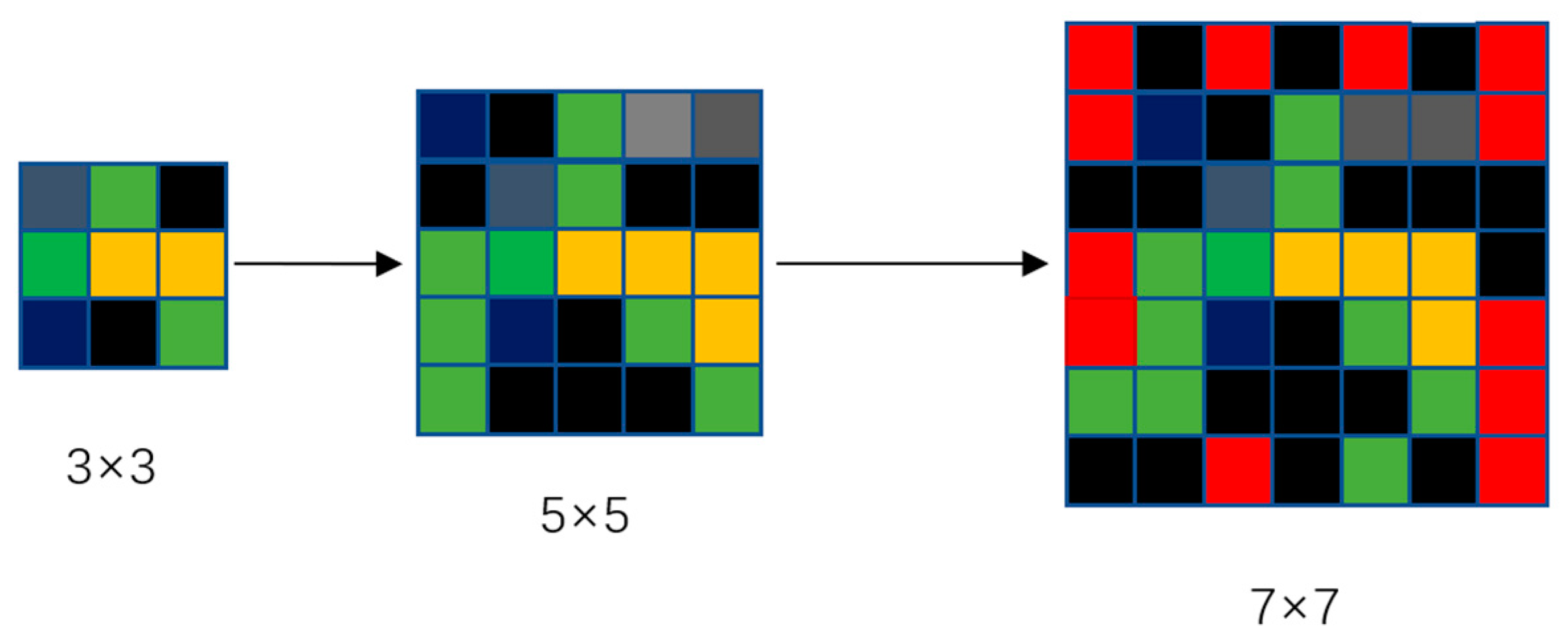
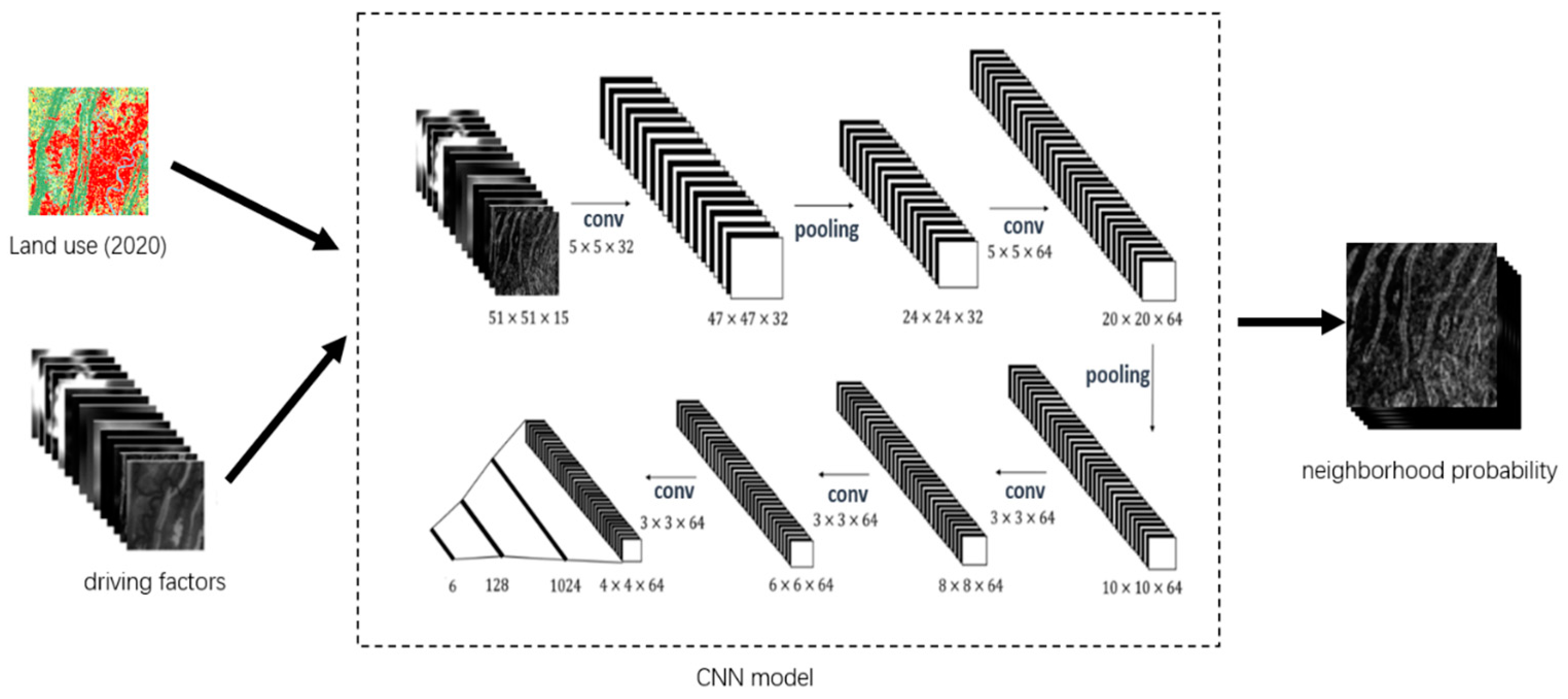
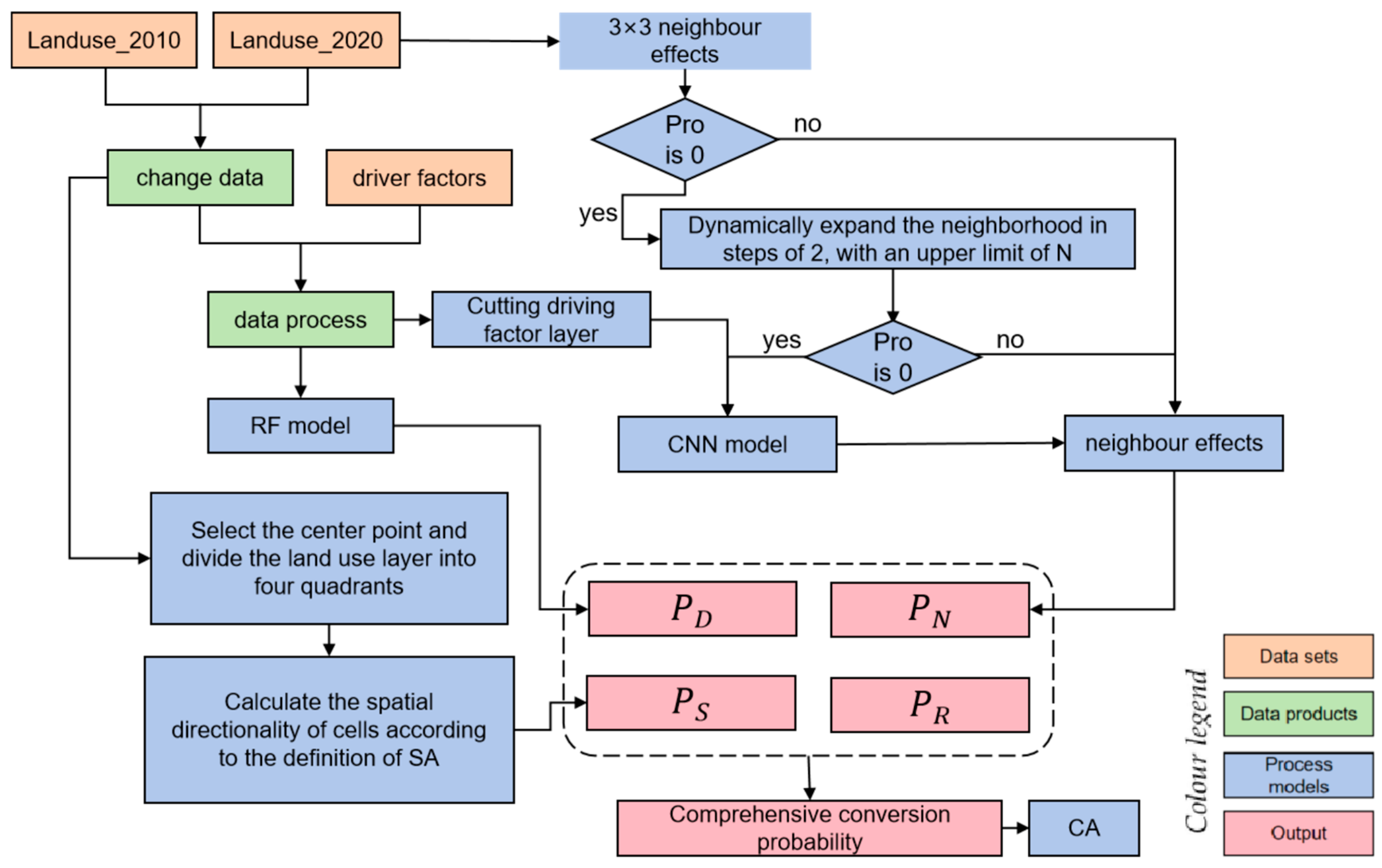


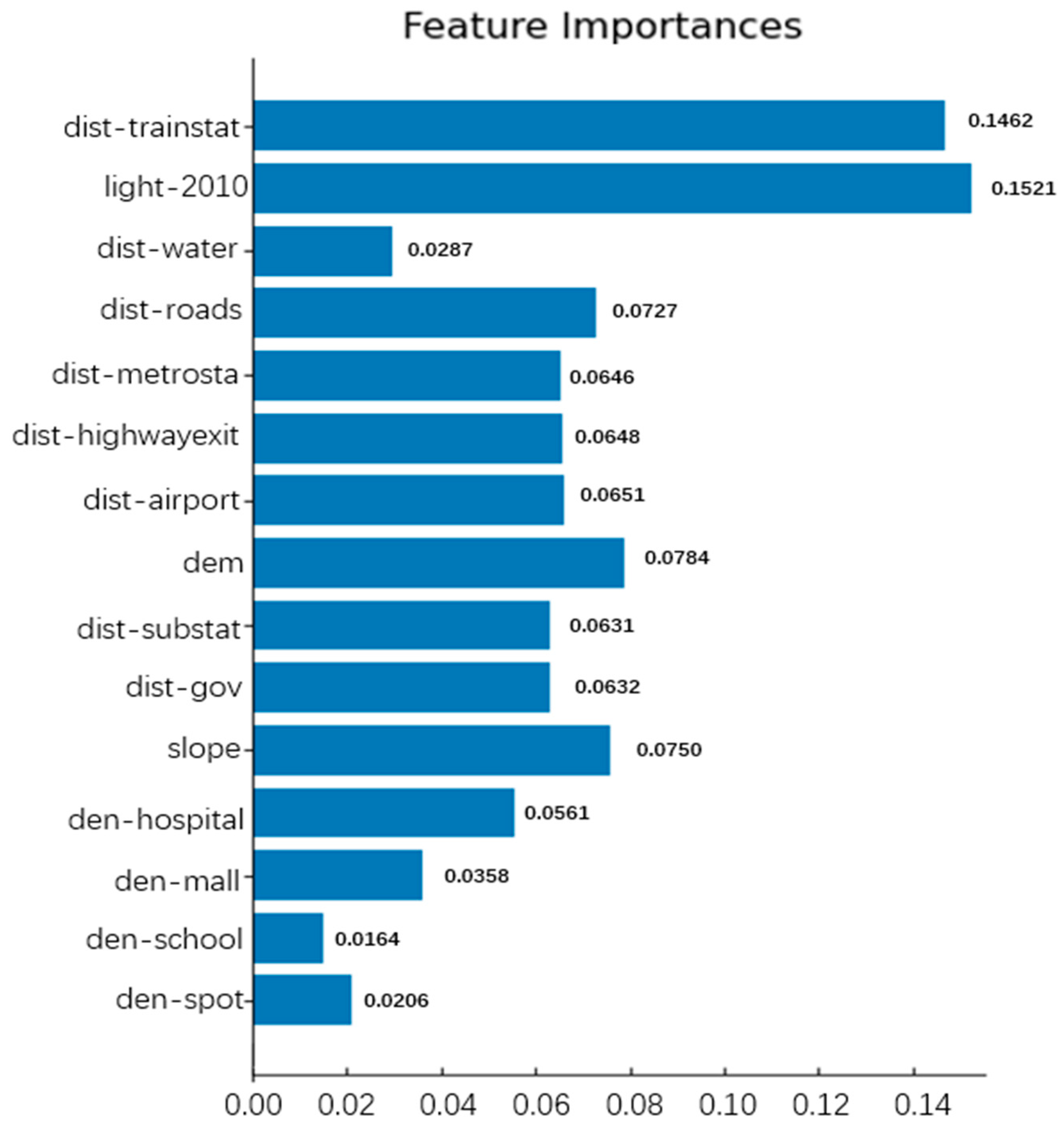
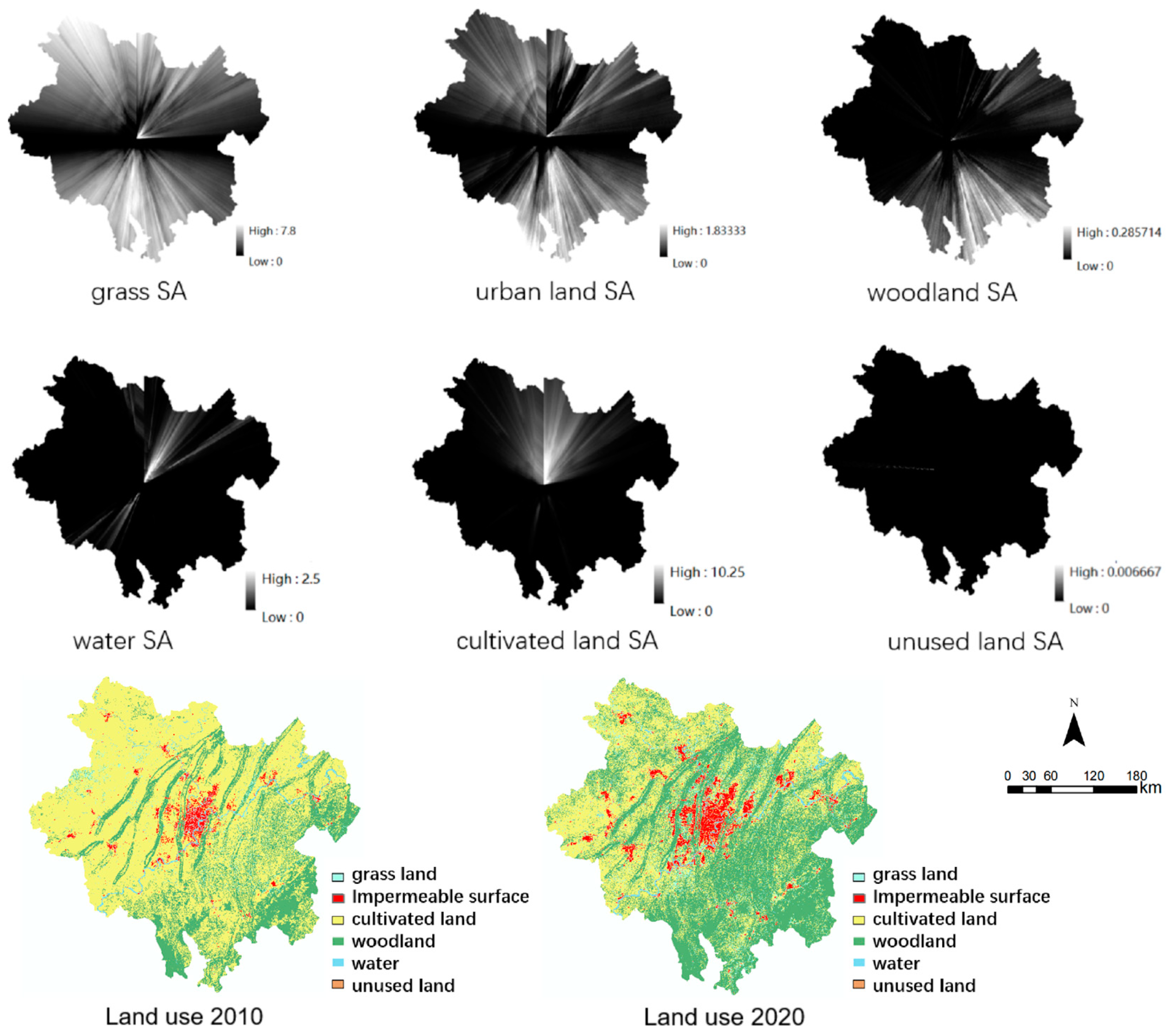


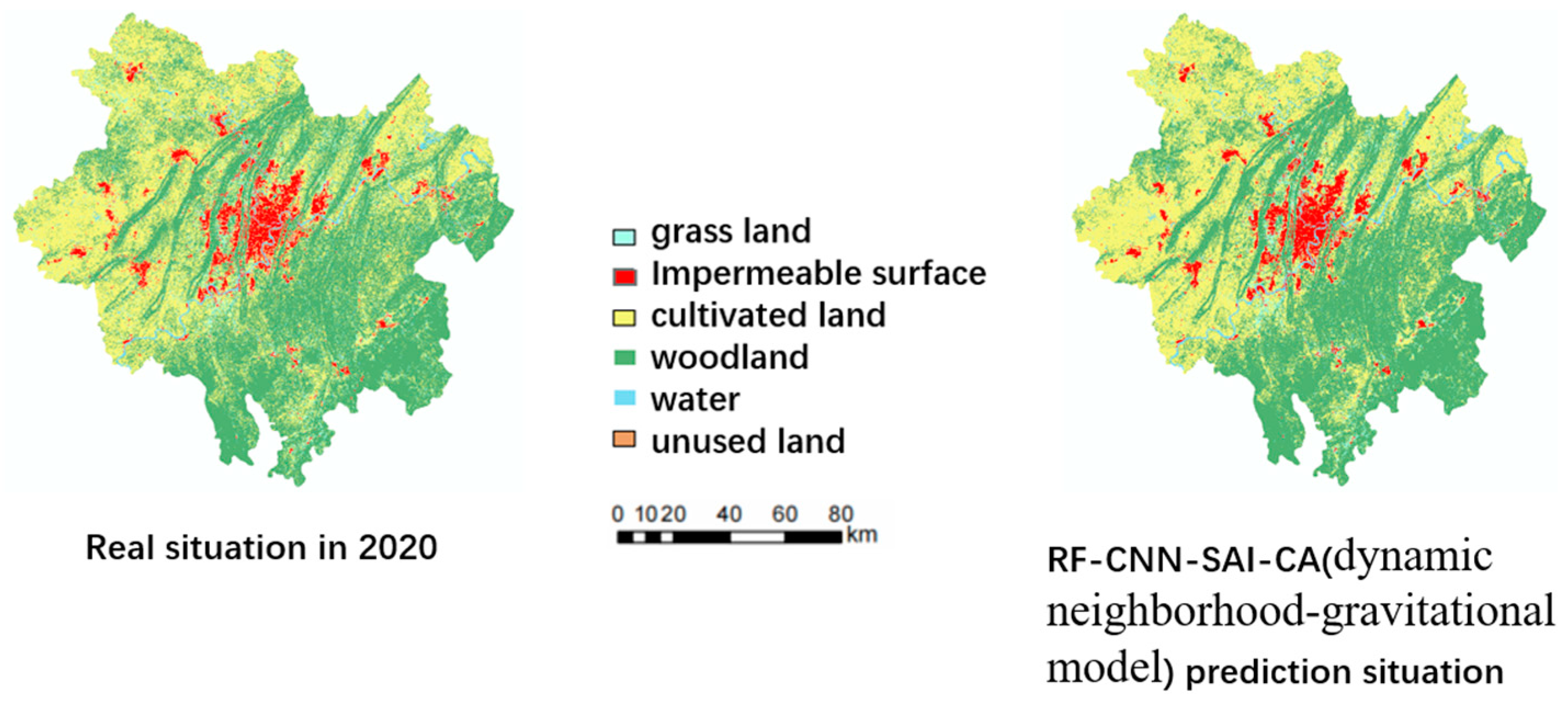
| Data Name | Year | Resolution | Source |
|---|---|---|---|
| Land Use | 2010–2020 | 30 m | FROM-GLC (accessed on 20 December 2022) |
| Slope | 100 m | Calculated from DEM | |
| DEM | 100 m | data.ess.tsinghua.edu.cn (accessed on 25 December 2022) | |
| Night Light | 2010 | 100 m | www.worldpop.org (accessed on 8 November 2022) |
| Water | 2010 | OpenStreetMap (accessed on 10 November 2022) | |
| Road Network | 2010 | www.openstreetmap.org (accessed on 6 April 2022) | |
| Point of interest | 2010–2020 | web scraping (accessed on 20 April 2022) |
Disclaimer/Publisher’s Note: The statements, opinions and data contained in all publications are solely those of the individual author(s) and contributor(s) and not of MDPI and/or the editor(s). MDPI and/or the editor(s) disclaim responsibility for any injury to people or property resulting from any ideas, methods, instructions or products referred to in the content. |
© 2024 by the authors. Licensee MDPI, Basel, Switzerland. This article is an open access article distributed under the terms and conditions of the Creative Commons Attribution (CC BY) license (https://creativecommons.org/licenses/by/4.0/).
Share and Cite
Liu, M.; Wang, J.; Luo, Q.; Sun, L.; Wang, E. Simulating Urban Expansion from the Perspective of Spatial Anisotropy and Expansion Neighborhood. ISPRS Int. J. Geo-Inf. 2024, 13, 91. https://doi.org/10.3390/ijgi13030091
Liu M, Wang J, Luo Q, Sun L, Wang E. Simulating Urban Expansion from the Perspective of Spatial Anisotropy and Expansion Neighborhood. ISPRS International Journal of Geo-Information. 2024; 13(3):91. https://doi.org/10.3390/ijgi13030091
Chicago/Turabian StyleLiu, Minghao, Jianxiang Wang, Qingxi Luo, Lingbo Sun, and Enming Wang. 2024. "Simulating Urban Expansion from the Perspective of Spatial Anisotropy and Expansion Neighborhood" ISPRS International Journal of Geo-Information 13, no. 3: 91. https://doi.org/10.3390/ijgi13030091
APA StyleLiu, M., Wang, J., Luo, Q., Sun, L., & Wang, E. (2024). Simulating Urban Expansion from the Perspective of Spatial Anisotropy and Expansion Neighborhood. ISPRS International Journal of Geo-Information, 13(3), 91. https://doi.org/10.3390/ijgi13030091




